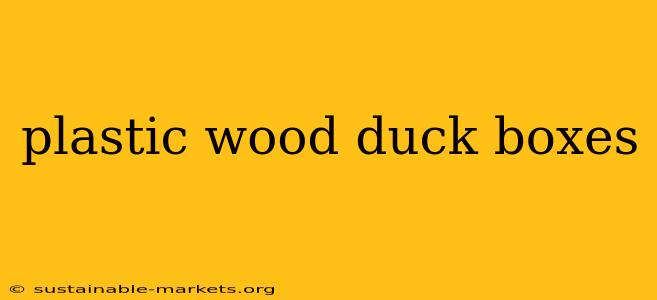Building and maintaining quality duck nesting boxes is crucial for supporting healthy waterfowl populations. Traditional wooden boxes, while effective, suffer from drawbacks like rot, insect infestation, and the need for frequent replacement. Enter plastic wood duck boxes: a durable, low-maintenance, and increasingly popular alternative for conservation efforts and backyard enthusiasts alike. This comprehensive guide explores the advantages, disadvantages, and considerations when choosing plastic wood duck boxes for your conservation project.
The Advantages of Plastic Wood Duck Boxes
Plastic wood duck boxes offer several key advantages over their traditional wooden counterparts:
Exceptional Durability and Longevity
- Resistance to Rot and Decay: Unlike wood, plastic wood doesn't rot or decay, even in consistently damp environments. This significantly extends the lifespan of the box, reducing the need for frequent replacements and minimizing environmental impact associated with disposal.
- Pest and Insect Resistance: Plastic is impervious to many common wood-boring insects and pests that can damage or destroy wooden boxes, ensuring the nesting cavity remains safe and structurally sound for years.
- Weather Resistance: Plastic wood can withstand harsh weather conditions, including extreme temperatures, heavy rainfall, and strong winds, maintaining its integrity and providing consistent shelter for nesting ducks.
Low Maintenance and Easy Cleaning
- Simplified Cleaning: Plastic's smooth, non-porous surface makes cleaning significantly easier. Old nests can be removed quickly and thoroughly, reducing the risk of disease transmission between nesting cycles.
- Reduced Repair Needs: The robust nature of plastic wood dramatically reduces the need for repairs, saving time and resources compared to maintaining wooden boxes that require regular patching and maintenance.
Eco-Friendly Considerations
- Reduced Environmental Impact: The long lifespan of plastic wood duck boxes minimizes the environmental burden associated with the production and disposal of frequent wooden replacements. Some manufacturers even utilize recycled materials in their construction, further contributing to sustainability.
Disadvantages of Plastic Wood Duck Boxes
While offering significant advantages, plastic wood duck boxes also have some potential drawbacks:
Potential for Overheating
Dark-colored plastic can absorb and retain heat, potentially leading to overheating inside the box during hot weather. Choosing light-colored boxes or adding ventilation can mitigate this issue.
Initial Cost
The upfront cost of plastic wood duck boxes may be higher than that of wooden boxes, although this is often offset by their extended lifespan and reduced maintenance costs in the long run.
Limited Aesthetic Appeal
Some may find the appearance of plastic wood less aesthetically pleasing than traditional wooden boxes. However, advancements in manufacturing are leading to boxes with increasingly natural-looking finishes.
Choosing the Right Plastic Wood Duck Box
When selecting a plastic wood duck box, consider the following factors:
- Size and Dimensions: Choose a box appropriate for the species of duck you intend to attract. Research recommended sizes for your local duck population.
- Entrance Hole Size: The size of the entrance hole should be appropriate for the target duck species to prevent access by predators while ensuring easy entry for the intended occupants.
- Ventilation: Adequate ventilation is crucial to prevent overheating, especially in warmer climates. Look for boxes with sufficient ventilation holes or slots.
- Mounting Options: Consider how you will mount the box, ensuring it is securely attached and inaccessible to predators.
- Material Quality: Choose boxes made from high-quality, durable plastic designed to withstand various weather conditions.
Conclusion
Plastic wood duck boxes present a compelling alternative to traditional wooden boxes for wildlife conservation. Their exceptional durability, low maintenance, and eco-friendly aspects make them a valuable tool for supporting waterfowl populations. While considering the potential drawbacks, the long-term benefits of plastic wood duck boxes significantly outweigh the limitations, offering a sustainable and effective solution for providing safe and secure nesting habitats for ducks.

